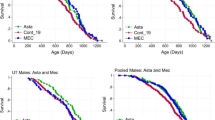Abstract
The effect of 2,3,7,8-tetrachlorodibenzo-p-dioxin (TCDD) administration on lipid peroxidation in various strains of responsive and non-responsive mice was determined. The hepatic content of thiobarbituric acid reactive substances (TBARS) was used as an index of lipid peroxidation, employing malondialdehyde as the standard. Six days after the administration of a single oral dose of 0.5 μg TCDD/kg to congenic male C57BL/6J mice, which were either homozygous (bb) or heterozygous (bd) with respect to the gene for the Ah locus, significant increases in hepatic lipid peroxidation were induced. Hepatic lipid peroxidation was induced in homozygous non-responsive (dd) mice by a dose of 25 μg TCDD /kg but not 0.5 μg/kg. In kidney, heart and testis, lower doses of TCDD produced lipid peroxidation in C57BL/6J bb and bd mice as compared to dd mice. The ability of TCDD to induce lipid peroxidation in B6D2F1/J, DBA2J and Swiss-Webster mice was also examined. A dose of 2,500 μg TCDD/kg produced the same level of lipid peroxidation in DBA/2J mice that was observed with 180 μg TCDD/kg in C57BL/6J bb and B6D2F1/J mice. Lipid peroxidation was not induced in kidney, heart, or testis at any of the doses of TCDD that were administered to DBA/2J mice. Thus, large strain differences exist in the ability of TCDD to induce lipid peroxidation in mice. In the liver, the ability to induce lipid peroxidation by TCDD is controlled in part by the Ah “b” allele, although other loci may play a major role.
Similar content being viewed by others
References
Al-Bayati ZAF, Murray WJ, Stohs SJ (1987) 2,3,7,8-Tetrachlorodibenzo-p-dioxin-induced lipid peroxidation in hepatic and extrahepatic tissues of male and female rats. Arch Environ Contam Toxicol 16:159–166
Birnbaum LS (1986) Distribution and excretion of 2,3,7,8-tetrachlorodibenzo-p-dioxin in congenic strains of mice which differ at the Ah locus. Drug Metab Distrib 14:34–40
Chapman L, Schiller CM (1985) Dose-related effects of 2,3,7,8-tetrachlorodibenzo-p-dioxin (TCDD) in C57BL/6J and DBA/2J mice. Toxicol Appl Pharmacol 78:147–157
Lowry OH, Rosebrough NJ, Fair WL, Randall RJ (1951) Protein measurement with the folin phenol reagent. J Biol Chem 193:265–275
Moore RW, Potter CL, Theobald HM, Robinson JA, Peterson RE (1985) Androgenic deficiency in male mice treated with 2,3,7,8-tetrachlorodibenzo-p-dioxin. Toxicol Appl Pharmacol 79:99–111
Nebert DW (1981) Genetic differences in susceptibility to chemically-induced myelotoxicity and leukemia. Environ Hlth Persp 39:11–22
Nebert DW, Negishi M, Lang MA, Hjelmeland LM and Eisen HJ (1982) The Ah locus, a multigene family necessary for survival in a chemically adverse environment: Comparison with the immune system. Adv Genet 21:1–52
Poland A, and Glover E. (1975) Genetic expression of aryl hydrocarbon hydroxygenase by 2,3,7,8-tetrachiorodibenzo-pdioxin: Evidence for a receptor mutation in genetically nonresponsive mice. Mol Pharmacol 11:389–398
Poland A, Glover E, Kende AS (1976) Stereo-specific, high affinity binding of 2,3,7,8-tetrachlorodibenzo-p-dioxin by hepatic cytosol. J Biol Chem 251:4936–4946
Poland A, Knutson, JC (1982) 2,3,7,8-tetrachlorodibenzo-pdioxin and related halogenated aromatic hydrocarbons: Examination of the mechanism of toxicity. Pharmacol Toxicol 22:517–554
Safe SH (1986) Comparative toxicology and mechanism of action of polychlorinated dibenzo-p-dioxins and dibenzofurans. Ann Rev Pharmacol Toxicol 26:371–399
Shara MA, Stohs SJ (1987) Biochemical and toxicological effects of 2,3,7,8-tetrachlorodibenzo-p-dioxin (TCDD) congeners in female rats. Arch Environ Contam Toxicol 16:599–605
Tukey RH, Hannah RR, Negishi M, Nebert DW, Eisen HJ (1982) The Ah locus: Correlations of intranuclear appearance of inducer-receptor complex with induction of cytochrome P-450 mRNA. Cell 31:275–284
Uchiyama M, Mihara M (1978) Determination of malonaldehyde precursor in tissues by thiobarbituric acid test. Anal Biochem 86:271–278
Author information
Authors and Affiliations
Rights and permissions
About this article
Cite this article
Mohammadpour, H., Murray, W.J. & Stohs, S.J. 2,3,7,8-Tetrachlorodibenzo-p-dioxin (TCDD)-induced lipid peroxidation in genetically responsive and non-responsive mice. Arch. Environ. Contam. Toxicol. 17, 645–650 (1988). https://doi.org/10.1007/BF01055833
Received:
Revised:
Issue Date:
DOI: https://doi.org/10.1007/BF01055833




